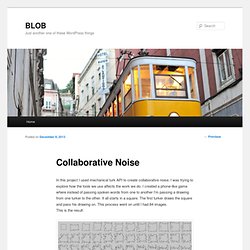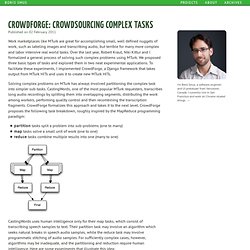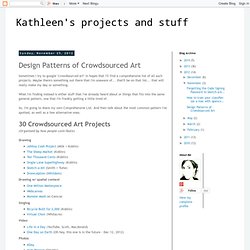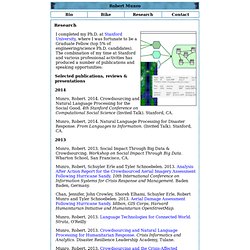

Collaborative Noise. In this project I used mechanical turk API to create collaborative noise.

I was trying to explore how the tools we use affects the work we do. I created a phone-like game where instead of passing spoken words from one to another I’m passing a drawing from one turker to the other. It all starts in a square. The first turker draws the square and pass his drawing on. This process went on until I had 84 images. Emoji Dick. Girl Turk: Mechanical Turk Meets Girl Talk's "Feed the Animals"
Girl Talk's Feed the Animals is one of my favorite albums this year, a hyperactive mish-mash sampling hundreds of songs from the last 45 years of popular music. Gregg Gillis created a beautiful, illegal mess of copyright clearance hell, which you should download immediately. (It's free, but I kicked in $20 for Gregg's legal fund and a copy of the CD.) Last month, Rex Sorgatz asked about collecting metadata on the album for data crunching. After spelunking through Billboard's chart history, that sounded like my idea of a good time. So I compiled all the data into spreadsheets, used Amazon's Mechanical Turk to collect some additional information, and pulled out a few charts.
Update (October 30): Here's the official sample list. Results Here's the final spreadsheet with all the collected data. There are 14 tracks on Feed the Animals, with a total of 264 sampled songs. Descriptive Camera - Matt Richardson, Creative Technologist. The Descriptive Camera works a lot like a regular camera—point it at subject and press the shutter button to capture the scene.

However, instead of producing an image, this prototype uses crowd sourcing to output a text description of the scene. Modern digital cameras capture gobs of "parsable" metadata about photos such as the camera's settings, the location of the photo, the date, and time, but they don't output any information about the content of the photo. The Descriptive Camera only outputs the metadata about the content.
As we amass an incredible amount of photos, it becomes increasingly difficult to manage our collections. Imagine if descriptive metadata about each photo could be appended to the image on the fly—information about who is in each photo, what they're doing, and their environment could become incredibly useful in being able to search, filter, and cross-reference our photo collections. Technology Presentation Video Results Acknowledgements. Drawing Surrealism. Sigir.dvi - mission4636.pdf. (1) Amazon Mechanical Turk: What are the most creative uses of Amazon's Mechanical Turk. CrowdForge: Crowdsourcing Complex Tasks.
Work marketplaces like MTurk are great for accomplishing small, well defined nuggets of work, such as labeling images and transcribing audio, but terrible for many more complex and labor intensive real world tasks.

Over the last year, Robert Kraut, Niki Kittur and I formalized a general process of solving such complex problems using MTurk. We proposed three basic types of tasks and explored them in two neat experimental applications. To facilitate these experiments, I implemented CrowdForge, a Django framework that takes output from MTurk HITs and uses it to create new MTurk HITs. Solving complex problems on MTurk has always involved partitioning the complex task into simpler sub-tasks. CastingWords, one of the most popular MTurk requesters, transcribes long audio recordings by splitting them into overlapping segments, distributing the work among workers, performing quality control and then recombining the transcription fragments.
Writing Articles Product Comparisons Sweet Applications. Design Patterns of Crowdsourced Art. Sometimes I try to google "crowdsourced art" in hopes that I'll find a comprehensive list of all such projects.

Maybe there's something out there that I'm unaware of... that'll be on that list... that will really make my day or something. What I'm finding instead is either stuff that I've already heard about or things that fits into the same general pattern, one that I'm frankly getting a little tired of. So, I'm going to share my own Comprehensive List. And then talk about the most common pattern I've spotted, as well as a few alternative ones. (Organized by how people contribute) Drawing Flat Contribution Model (v1) The Life in a Day project is a great example of how tons of effort and creativity were filtered down into one consumable artifact.
The gist of the model is this: There's some prompt, people go out and do it on their own, submit their creations, and then some curator accepts or denies their contribution and integrates it into the One True Artifact. Flat Contribution Model (v2) Aaron Koblin - Work. Robert Munro - Research. I completed my Ph.D. at Stanford University, where I was fortunate to be a Graduate Fellow (top 5% of engineering/science Ph.D. candidates).

The combination of my time at Stanford and various professional activities has produced a number of publications and speaking opportunities: Selected publications, reviews & presentations Munro, Robert. 2014. Crowdsourcing and Natural Language Processing for the Social Good. 4th Stanford Conference on Computational Social Science (Invited Talk).